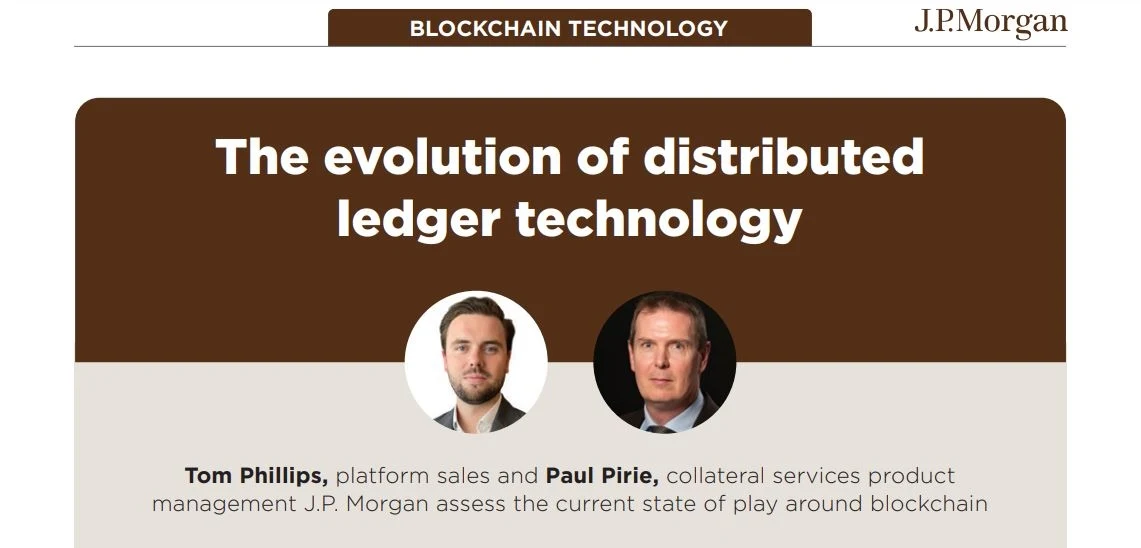Collateral Management Guide 2023: The evolution of DLT
12th October, 2022 | Tom Phillips and Paul Pirie, J.P. Morgan

This Thought Leadership article is part of the Collateral Management, 2023 edition, which can be accessed here.
Blockchain technology first hit the mainstream with the emergence of cryptocurrencies, most notably Bitcoin. Whilst the application of bitcoin may not have reached the heights that its founder once hoped for, it’s safe to say the use cases emerging from the underlying technology have exceeded initial expectations.
For financial service companies the technology could pave the way for faster and cheaper transactions, automated contracts and greater security. These benefits have resulted in a number of use cases and proof-of-concept projects which have become commonplace in recent years. At a high level, blockchain is a digital database that is able to provide a clear record of transactions and balances for a specified asset.
It enables instantaneous and indisputable settlement and acts as a single source of truth for asset ownership. There is one key difference that we see between different blockchains - whether they are permissioned or public.
Let’s take J.P. Morgan’s blockchain (Onyx) as an example. Onyx is a permissioned blockchain, where actors are granted access by a controlled, centralised authority. On the other hand, blockchains such as Ethereum are public, which means anyone is able to view the record of ownership at any time, as long as they have an internet connection.
As we look at the benefits that distributed ledger technology (DLT) can provide, it won’t come as a surprise to learn that a number of institutions have started to carve out focused digital groups within their organisations to identify potential use cases. Until recently, it has primarily been sell-side participants that have been allocating resources towards digital groups and projects.
More and more this is branching out, with strategic partnerships announced on a regular basis between buy-side participants and digital asset innovators. To analyse the state of play of DLT initiatives we have grouped a number of use cases and highlighted some of the benefits.
Tokenisation of traditional assets
To reap the benefits that DLT has to offer with traditional assets, one must first be able to represent the asset on a blockchain. This is the ‘tokenisation’ process and is where, in many instances, tri-party agents have had a key role to play. Clients will allocate an asset through a regular tri-party structure to a blockchain’s trusted third party (TTP) or collateral token agent (CTA). In doing this, the collateral is secured as it would be normally for a traditional securities financing transaction.
It is this ‘locking-up’ process that enables the asset to be tokenised onto a blockchain. This can also be achieved at a custodian level, with the appropriate segregation of assets into a CTA account. This multi-pronged approach to tokenisation provides clients with the flexibility to hold the assets at their preferred location.
We have already seen a variety of successful cases that utilise the tokenisation of traditional assets. J.P. Morgan’s DLT repo application has processed over $300bn of transactions to date and allows tokenised collateral to be exchanged for tokenised cash. HQLAx - in which J.P. Morgan is a strategic investor - recently announced a successful pilot trade for a securities lending transaction using the HQLAx DLT platform.
Earlier in the year, J.P. Morgan unlocked BlackRock money market funds to be used as collateral via tokenisation. There are plans to expand this into other asset classes as we build out our tokenised collateral network (TCN) application. Note that this is far from a conclusive list, with many other DLT based projects being worked on in the market.
So what are the benefits that can be gained from tokenising traditional assets? Instantaneous settlement is the standout as it enables the frictionless transfer of collateral, reduces counterparty risk, and allows clients to manage intra-day liquidity with the ability to execute trades within a much shorter time horizon. In addition, assets can be moved outside of their traditional market hours, and tokenisation has enabled the ‘unlocking’ of trapped or hard-to-fund assets.
Natively issued assets
Whilst tokenisation of traditional assets provides numerous benefits, we remain constrained by the traditional market infrastructure. What about securities that exist only on-chain for their whole life cycle (issuance, trading, asset servicing, maturity)? Some certainly see this as the way forward. A great example of this was seen in 2021 when the European Investment Bank issued its first ever digital bond on Ethereum’s public blockchain. The blockchain acts as the custodial record for the bond, which can be transferred between participants’ wallet addresses via a tried and tested settlement process.
As with tokenised traditional assets, these natively digital assets offer much greater settlement efficiency. Settlement of the digital EIB bond occurs in hours rather than days, which enables participants to free up liquidity and greatly reduces the counterparty risk. In addition, there is a reduction in the number of intermediary actors which lowers fixed costs, whilst providing greater market transparency with regards to asset ownership given the readable nature of Ethereum’s public chain.
Thus far, such natively digital issuances have replicated the attributes of a traditional bond and the stages in traditional issuance on a blockchain. The next stage for natively digital assets is to prove liquidity through various transactional use cases in order to match long-established traditional markets.
It is yet to be seen whether public or private chains will take the lion’s share of natively issued securities.
Crypto prime
With the expansion of cryptocurrency markets, crypto prime brokers such as Coinbase have also become mainstream. They offer similar services to a traditional prime broker, but for the more volatile cryptocurrencies. While their purpose is different from that of tokenised and natively issued assets, as described above, they have played a role in bridging traditional markets with the emerging ‘crypto markets’ – as can be seen with the crypto financing transactions that were announced earlier in the year.
Crypto prime is a nascent business with tiny volumes in a niche market – a germinating seed in the digital financial marketplace. But what will it grow into?
Central bank digital currencies
Without digital cash to facilitate true DvP on and across blockchains, we will not realise the full potential of the digital revolution in financial markets. This is where central bank digital currency or CBDC comes into the equation.
Almost all major central banks have CBDC projects. But do we really need them? This is a very divisive topic, with some firmly believing that having true CBDCs is a very bad idea and that other solutions such as the ‘trigger mechanism’ are far more efficient to support capital market liquidity. Then there is the question of whether digital currencies should be separated somehow between wholesale and retail flows. In the meantime, institutions like J.P. Morgan are creating atomic DvP within their private permissioned chains through JPM Coin, which is a digital representation of USD cash on ledger.
This can be used to instantaneously move cash between J.P. Morgan’s customers, which can at any time be converted back into fiat USD and moved into the financial markets.
What is clear is that there is an opportunity to rethink the way cash and liquidity flow both in the wholesale financial industry and between individuals.
Where do we see traction?
While many of the initiatives mentioned above are in their infancy, we see some clear themes that are progressing more quickly by providing immediate value-add to their participants. Tokenisation of traditional assets is the leader, which makes sense as the first step in the digitisation process.
DLT repo products have had extremely positive uptake as they provide desks with the tools to manage liquidity like never before. DLT enables the collateral and cash tokens to be exchanged simultaneously, thereby eliminating intra-day credit exposure and operational risk, as well as the associated capital and liquidity costs.
Demand will only increase as capabilities expand across currencies, to term and further down the collateral curve. The market understands traditional assets and how they work. With tokenised traditional assets, the most prevalent hurdle is getting comfortable with DLT representing true ownership and security interest for the underlying asset being tokenised. Expect to see further use cases in 2023 as desks look to increase efficiencies with traditional assets they have access to today and try to unlock trapped assets using the technology.
The next question is how comfortable collateral receivers will be with their ability to liquidate the underlying asset, especially in more esoteric markets. When we consider which market participants are gaining the most traction with this new technology, there are two standout factors.
The first is when the institution has a segregated digital assets group within their business, and the second is when the desk that is responsible for collateral management has an ongoing and open dialogue with these groups. There is a clear correlation between this and the level of discussion that we are having with our clients.
ISLA’s appointment of Ashurst to work on legal analysis of the GMSLA as it relates to digital assets is most welcome to the industry. Industry bodies and regulators providing this clarity will allow the market to move forward and for other participants to start allocating required resources to make progress. Tokenisation is a massive focus across the whole industry, both in established organisations and fintechs.
Right now, the benefits will be creating efficiencies, reducing costs and increasing speed in existing trade flows – particularly post-trade. Tokenisation alone cannot create liquidity in a non-liquid asset, but as the market accepts and adopts the concept we will start to see market makers and primary dealers creating secondary markets in previously impossible scenarios as they spot new opportunities to make money and generate liquidity.
If you look around, this is already happening and waiting to gain momentum and bridge the gap into the mainstream.
Challenges
Although the advancements made utilising DLT have clear benefits – increased efficiency, reduced costs and the potential to solve for binding constraints – it doesn’t come without challenges.
Currently, not everyone has the DLT infrastructure and resources to participate and integrate with the uses we highlighted earlier. Even when they do, organisations still face the challenge of upgrading a variety of existing systems. For example, when we consider intra-day repo transactions that DLT enables, system upgrades will be required to book these trades correctly. In the medium term, firms will have to deal with a hybrid portfolio of digital and traditional assets. This will likely increase costs and arguably reduce efficiency as they are forced to run new and legacy tech stacks in parallel.
Existing market infrastructure providers will also need to focus on integrating traditional and digital environments. SWIFT has long been the market standard for messaging, but its use is not as common in a digital world. Firms need to be able to connect with new counterparts and solution providers alongside their existing setups for traditional assets.
In its current state, the traditional custodial layer does not exist with natively issued assets. This may result in firms being left to manage a variety of wallets for each blockchain and issuance registrar. We must focus on ensuring that market fragmentation doesn’t increase. It is important that we find interoperability between blockchains to avoid carrying over old problems into these new solutions. Enabling different blockchains to interact with each other is not an easy task, but third party technology providers might be able to help bridge this gap.
While there will be fintech solutions to help us on this journey, economic viability along the trade flow must remain. If we require multiple intermediaries to enable these solutions, we increase the risk of losing the cost saving benefit that DLT promises. However, even with all the challenges mentioned above, we must not ignore the benefits that this technology can bring.
Organisations must start to understand what role DLT will play in their business, and the market must focus on leaving behind inefficiencies that the current infrastructure presents. Making progress There is no blueprint for organisations to follow, but J.P. Morgan’s experiences highlight key points to consider.
As mentioned earlier, we see a clear correlation between the depth of conversations we have with clients and how integrated they are with their digital groups. If your organisation has a digital group, now is the time to start having a discussion with them – even if it is only to understand what they are working on. You may be surprised by some of the potential use cases for your business that they can identify.
Collaboration is important to make progress with the opportunities that DLT presents. If your organisation doesn’t have a dedicated digital group, then turn to clients, peers, fintechs and other service providers. Your J.P. Morgan coverage team is here to help navigate these discussions across our business lines. It is natural that throughout this transition firms will rely on their existing infrastructure.
However, we must not lose sight of the fact that this is an opportunity to upgrade and adopt new technology stacks. The build-or-buy analysis is more important than ever. Take time to analyse the benefits of each path. This structural change is happening quickly, and your system architecture will need to keep up.


